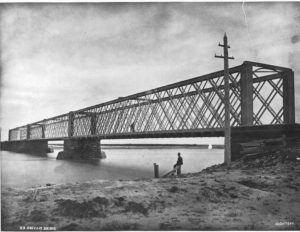The notion of unifying the separate colonies of British North America was discussed increasingly in the 1860s. Many felt that the American Civil war was the result of weak central government and wished to avoid such violence and chaos. The 1864 Charlottetown Conference was intended to discuss a Maritime Union, but concerns over possible conquest by the Americans, coupled with a belief that Britain was unwilling to defend its colonies against American attack, led to a request from the Province of Canada (now Ontario and Quebec) to expand the meeting’s scope. In 1866 the US cancelled the Canadian–American Reciprocity Treaty, leading to loss of trade with New England and prompting a desire to build trade within British North America, while Fenian raids increased support for union. On 1 July, 1867, New Brunswick entered the Canadian Confederation along with Nova Scotia and the Province of Canada.
Modern New Brunswick:
Confederation brought into existence the Intercolonial Railway in 1872, a consolidation of the existing Nova Scotia Railway, European and North American Railway, and Grand Trunk Railway. In 1879 John A. Macdonald’s Conservatives enacted the National Policy which called for high tariffs and opposed free trade, disrupting the trading relationship between the Maritimes and New England. The economic situation was worsened by the decline of the wooden ship building industry. The railways and tariffs did foster the growth of new industries in the province such as textile manufacturing, iron mills, and sugar refineries, many of which eventually failed to compete with better capitalized industry in central Canada.

In 1937 New Brunswick had the highest infant mortality and illiteracy rates in Canada. At the end of the Great Depression the New Brunswick standard of living was much below the Canadian average. In 1940 the Rowell–Sirois Commission reported that federal government attempts to manage the depression illustrated grave flaws in the Canadian constitution. While the federal government had most of the revenue gathering powers, the provinces had many expenditure responsibilities such as healthcare, education, and welfare, which were becoming increasingly expensive. The Commission recommended the creation of equalization payments, implemented in 1957.
The Acadians in northern New Brunswick had long been geographically and linguistically isolated from the more numerous English speakers to the south. The population of French origin grew dramatically after Confederation, from about 16 per cent in 1871 to 34 per cent in 1931. Government services were often not available in French, and the infrastructure in Francophone areas was less developed than elsewhere. In 1960 Premier Louis Robichaud embarked on the New Brunswick Equal Opportunity program, in which education, rural road maintenance, and healthcare fell under the sole jurisdiction of a provincial government that insisted on equal coverage throughout the province, rather than the former county-based system.
Geography:
Roughly square, New Brunswick is bordered on the north by Quebec, on the east by the Atlantic Ocean, on the south by the Bay of Fundy, and on the west by the US state of Maine. The southeast corner of the province is connected to Nova Scotia at the isthmus of Chignecto.
